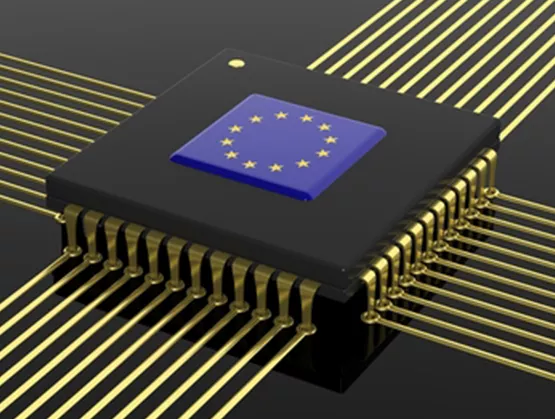
SEMICON Europa 2022 (Munich, 15-17 November) attendees gathered at the Executive Forum for the Opening Ceremony on day one to hear from industry leaders and gain insights into the latest market and technology trends. Keynote speakers shared perspectives on the global challenges confronting the electronics industry and collaborative solutions to support the anticipated industry growth in the coming years. Among the topics discussed were accelerating innovation through collaborative research and development, creating a roadmap for greener and more trusted applications and the role semiconductors play in doing so, and challenges and opportunities in manufacturing excellence and global supply chain optimization.
While there’s no denying that the industry is facing substantial, short-term supply chain challenges, the atmosphere at SEMICON Europa was vibrant and optimistic. Speakers painted a promising picture as we move into the second half of this decade. Ajit Manocha, president and CEO of SEMI, highlighted that after the first 52 years of SEMI’s existence, the industry has reached around $500 billion USD in annual revenues. However, in less than 10 years’ time, the annual value of semiconductor sales is expected to have more than doubled to $1.3 trillion USD. He noted, "The fundamentals of our industry are super-strong. I only wish I was entering the industry now, rather than when I did 40 years ago – it’s such an exciting time in the semiconductor business!”
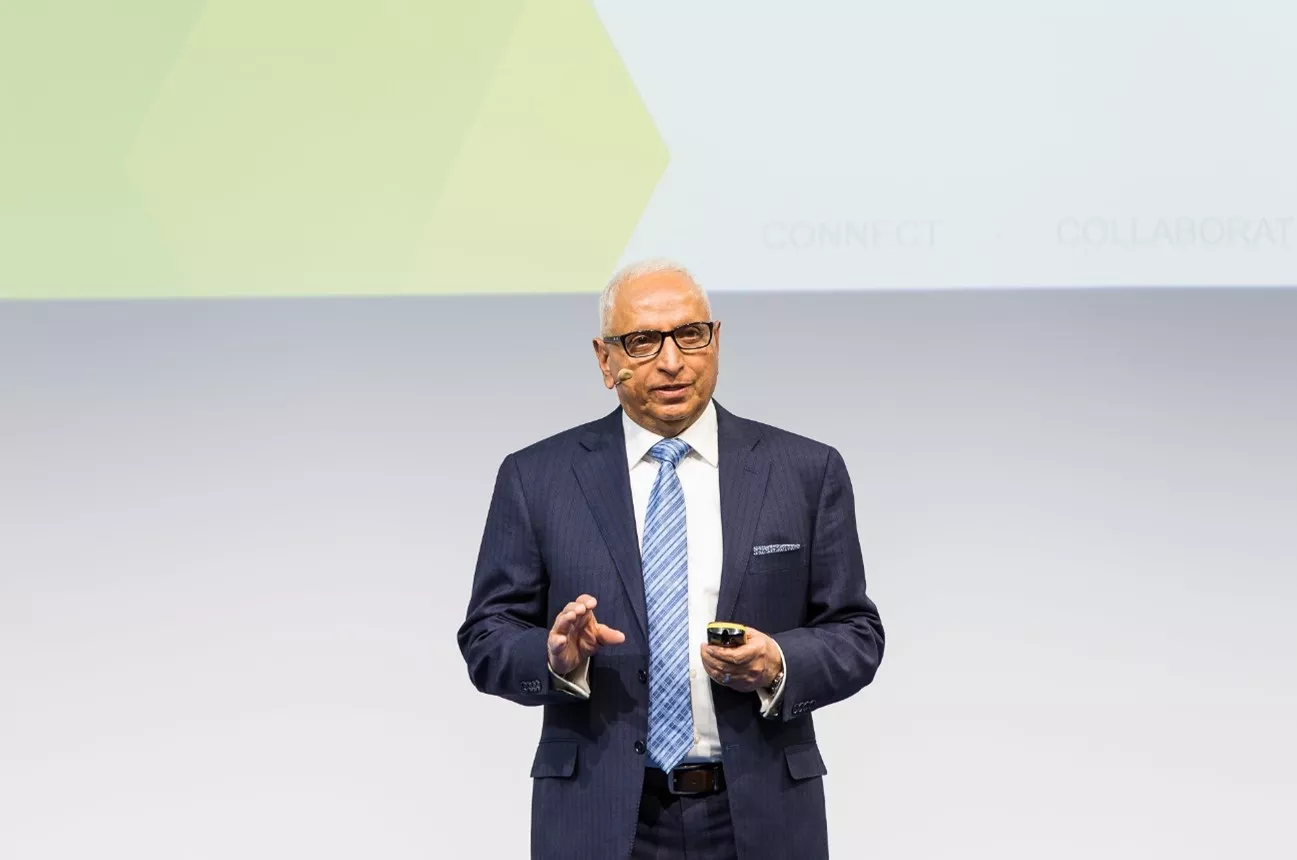
Ajit Manocha, President and CEO at SEMI
This rapid growth brings challenges as well as opportunities, not least in ensuring that increased semiconductor production goes hand-in-hand with reduced industry-wide climate impact. Key themes – supply chain disruption, and the prospect of accelerating growth – underpinned the contributions from a mix of industry and government representatives, the semiconductor supply chain, and buyers of semiconductors.
Data is the New Oil
The optimistic vision of the industry stems from an analysis of the powerful technological forces shaping the world today. The most important is data: analysis suggests that by 2025, more data will be created by machines than by people. This flood of data will be generated by the application of artificial intelligence (AI) and machine learning technologies, and by billions of devices using the vast bandwidth provided by optical and wireless 5G and then 6G networks to connect to each other and to the cloud. As Laith Altimime, President of SEMI Europe, observed, “AI and machine learning are being deployed in all industries – they are the instrumental in advancing the digital transformation.”
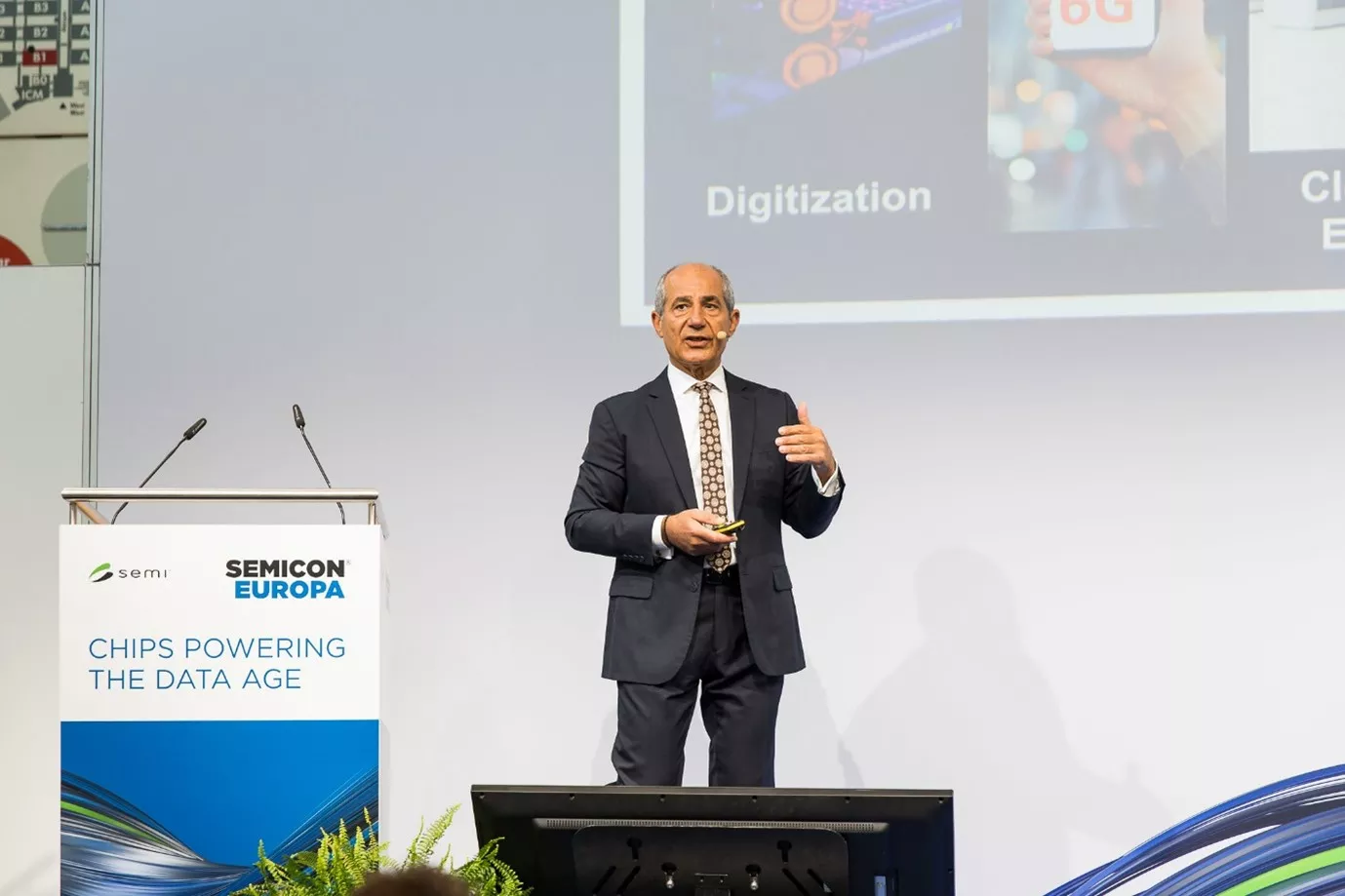
Laith Altimime, President of SEMI Europe
Keynote speakers representing the end markets bore witness to the truth of this analysis. Barbara Frenkel, a member of the executive board of Porsche with responsibility for procurement, described how the company conceives of its products as software-defined vehicles. The demand from customers to embed higher levels of automation, connectivity, safety, and infotainment in cars is rapidly increasing the data-processing capabilities which Porsche’s designers build into its products.
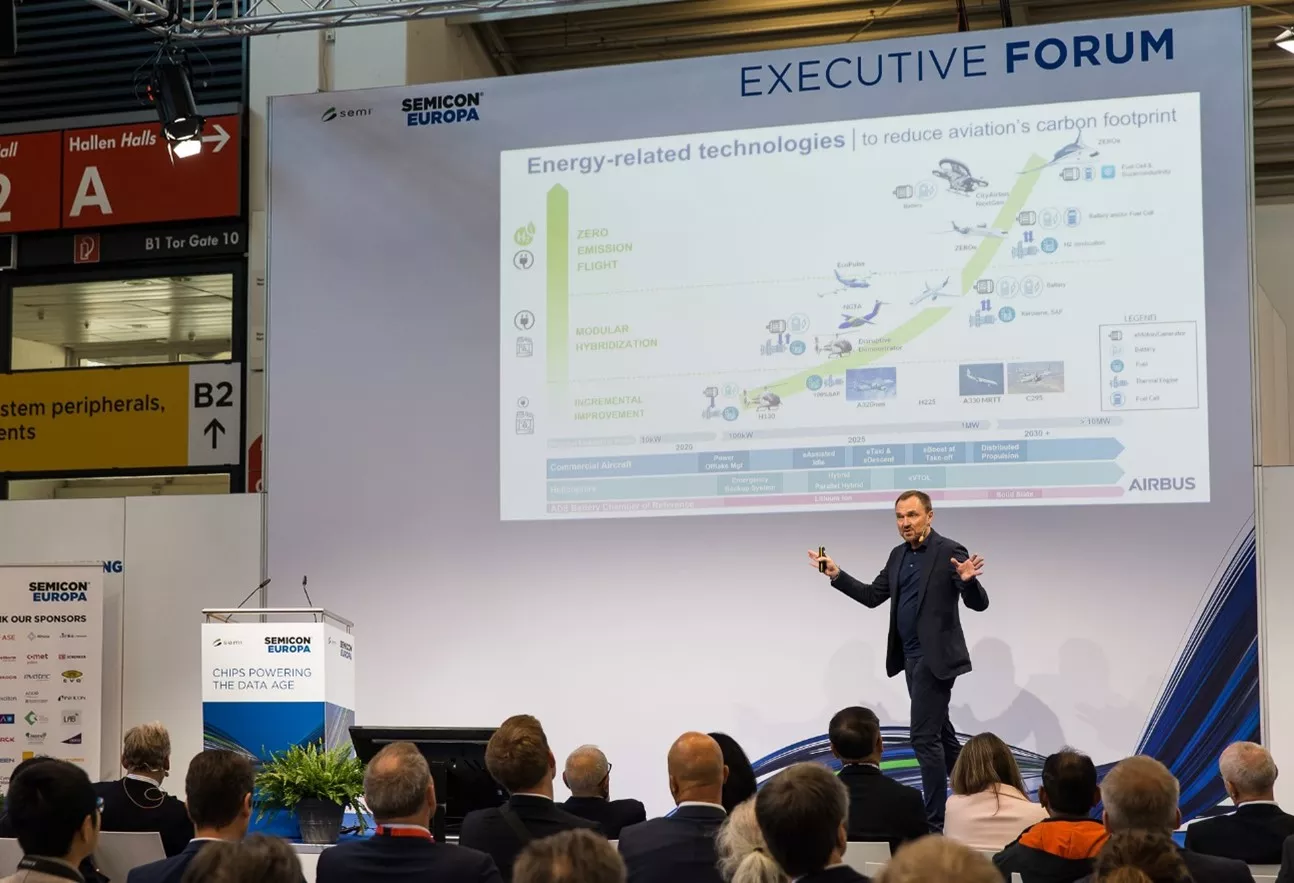
Grzegorz Ombach, Head of Disruptive R&T and Senior Vice President at Airbus
Grzegorz Ombach, Head of Disruptive R&T and Senior Vice President at Airbus, highlighted a similar trend in aircraft towards more autonomous operation alongside more powerful safety and data security technologies – all creating more data and requiring higher data processing capacity.
Several speakers summed up this trend with the notion that Data is the New Oil. The value of many companies today lies in the data it holds as much as its products. Referring to data-driven innovations such as mRNA vaccines, Luc Van den hove, president and CEO of imec, remarked that with the help of AI, pharmaceutical companies will become data companies.
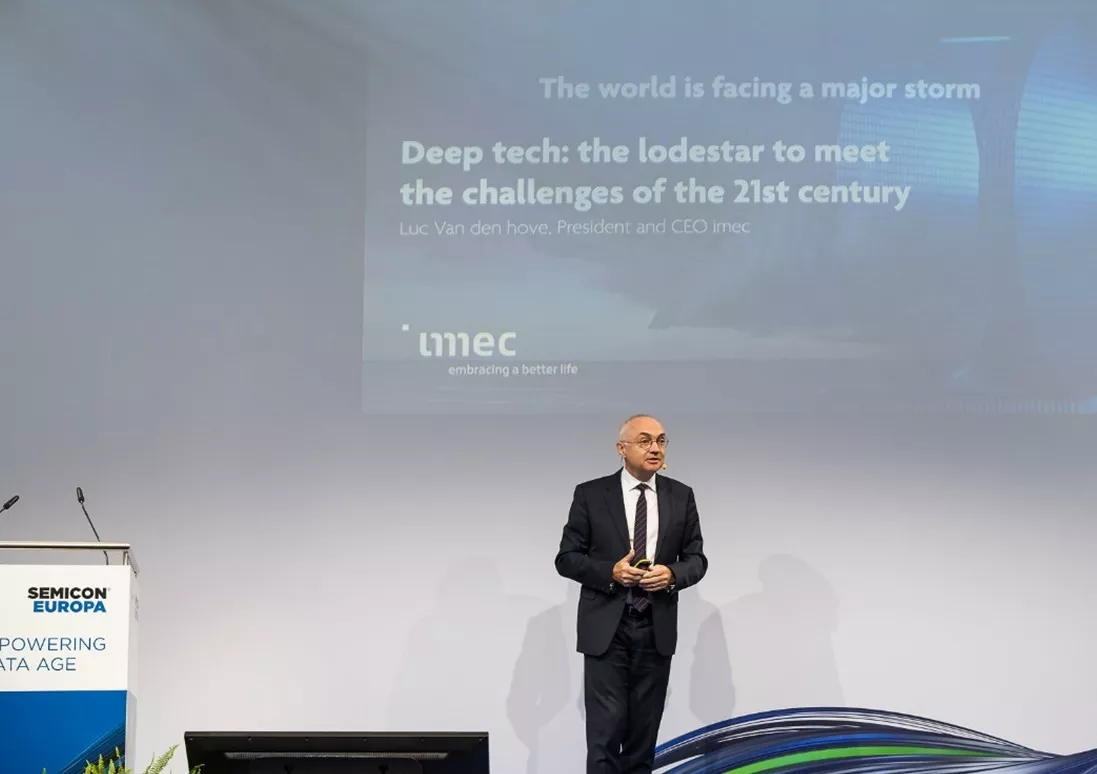
Luc Van den hove, President and CEO at imec
This insight was echoed by Laura Matz, Chief Science and Technology Officer of Merck and CEO of Athinia, as she described the company’s Syntropy initiative, a novel attempt to provide a secure, confidential, and standardized platform for healthcare practitioners and institutions to share patient and operational data. Syntropy, she said, brings about dramatic improvements in the efficiency of data curation – the essential precursor to intelligent data analytics.
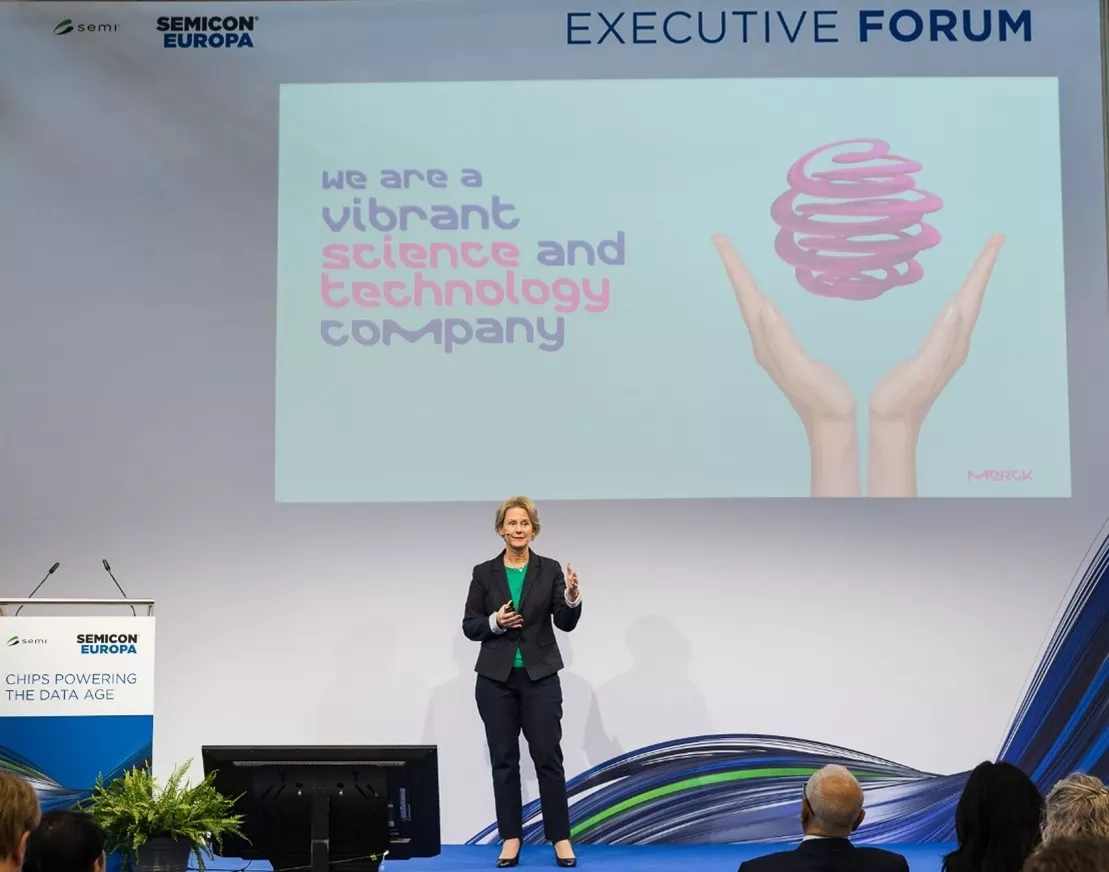
Laura Matz, Chief Science and Technology Officer at Merck and CEO at Athinia
However, it’s not just data that is driving semiconductor industry growth; electrification and digitization are powerful tailwinds pushing the industry forward. Frenkel and Ombach both described how electrification is increasing the value of the semiconductor content in cars and planes, particularly for the latest silicon carbide (SiC) and other wide bandgap semiconductor devices which provide for the greatest power-conversion efficiency.
Laith Altimime noted that the opportunity was particularly attractive to Europe because of the region’s strength in the automotive, industrial, and medical markets, where Europe has a broad and comprehensive semiconductor supply chain. The European Chips Act, a proposal to support the creation of additional advanced semiconductor fabrication capacity, puts the region in a sound long-term position to match semiconductor output with demand, he said.
In the short term, however, the picture is not quite as rosy.
Leading-Edge Nodes Vital to Innovation, but Legacy Nodes Still Critical for Key Markets
The pandemic has caused immense disruption to OEMs’ production operations – and in the case of Royal Philips, a world-leading manufacturer of high-tech medical imaging and other equipment, it continues to do so. In his talk entitled Chips for Lives, Frans van Houten, a non-executive director of pharmaceuticals firm Novartis and a former CEO of Philips, described how the semiconductor industry’s failure to supply chips to Philips limits production of critical equipment. This equipment can predict a patient’s probability of suffering a heart attack, detect early that a pregnant woman will have a difficult birth, and enable treatment to be administered that will prevent premature, avoidable deaths. As declared by van Houten, the chips in Philips products save lives.
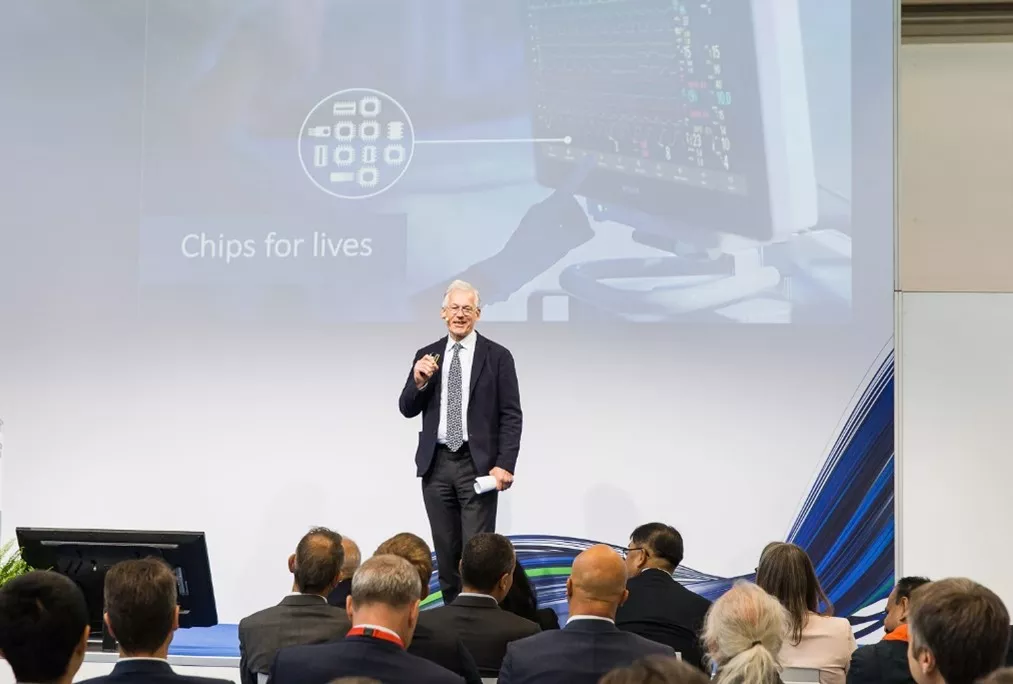
Frans van Houten, Director at Novartis; Former CEO at Royal Philips
Yet such chips are today extremely difficult to procure. This is partly due to the long development cycle of advanced medical imaging equipment, which means that the chips embedded in a new design could already be up to 12 years old and are fabricated on mature nodes. Further adding to the procurement challenge, the volumes which Philips buys are small – a few thousand a year, despite the fact that each unit of Philips equipment can itself cost several million dollars. van Houten highlighted that, in his experience, the CEOs of semiconductor companies do not want to manufacture chips on old nodes and in small quantities.
Obsolescence of the semiconductor products on which Philips equipment is based forces the company to employ some 1,000 engineers full-time to re-design electronics systems with replacement parts. He summarized that despite the life-saving importance of the products that Philips makes, “the semiconductor supply chain simply does not work for us.”
Barbara Frenkel noted that Porsche faced similar difficulties in obtaining sufficient quantity of semiconductors during the pandemic. Much of the automotive demand is also for products from mature nodes and total automotive industry demand for semiconductors is set to triple by 2030.
She described Porsche’s strategic approach to the supply chain problem: for the first time, Porsche has formed direct relationships with semiconductor manufacturers, adding to its relationships with Tier One suppliers. It has developed in-house expertise in the semiconductor supply chain and is now able to analyze the supply chain in detail, right down to the level of individual part numbers. On this, she said, “A feature of the Porsche Semiconductor Framework includes a risk management tool which reliably detects bottlenecks in the semiconductor supply chain and enables us to take mitigation actions for any at-risk part number.”
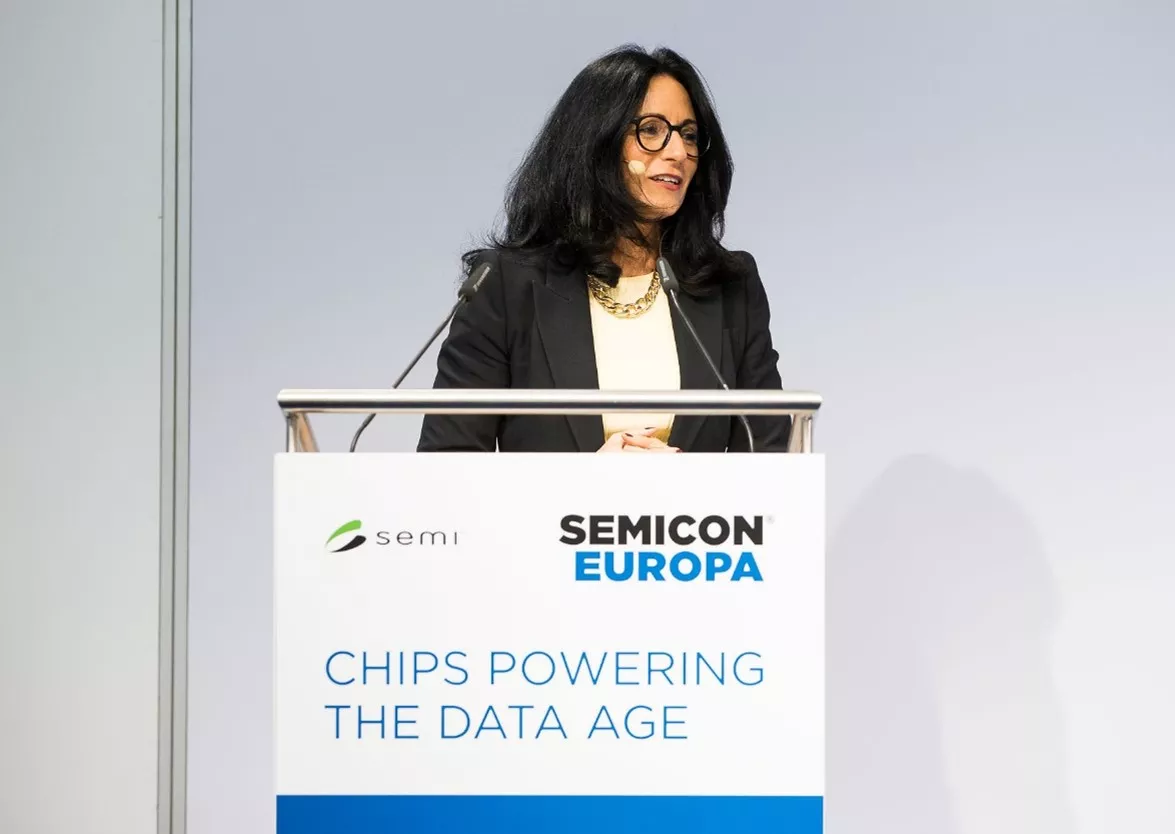
Barbara Frenkel, Member of the Executive Board and Procurement at Porsche AG
The insights which she has made since Porsche has adopted a strategic framework for semiconductor procurement mirror those of van Houten. While welcoming the European Chips Act’s investment in fabrication capacity, she highlighted it was crucial to avoid focusing only on the leading-edge of semiconductor technology. “We need more volume not only at the leading-edge, but also in legacy nodes, even those older than 40nm.” She also called on the industry and its customers to adopt Porsche’s new approach to supply chain management, proclaiming, “We all need to re-design the supply chain, to move from optimizing for efficiency to optimizing for the ability to adapt.”
Increasing Manufacturing Capacity to Keep Pace with Data Growth
While Porsche and Philips described the measures they are taking to cope with today’s chip shortages, semiconductor industry speakers provided insights into the ways that new chip-making capacity could come on stream. These contributions ranged from the government level – Amitesh Kumar Sinha, CEO of the Semiconductor Mission of the Government of India, described the various incentives and funding options available to support the construction in India of new semiconductor fabrication plants at both leading-edge and mature nodes – and the corporate level – Axel Fischer, Vice President of the EMEA Foundry Business at Samsung Semiconductor, called the foundry the driving force for innovation in electronics.
However, he urged that collaboration across the supply chain was going to be more important than ever, as new and more specialized semiconductor technologies would need to be applied across multiple product types if the volumes required were to reach economically viable levels.
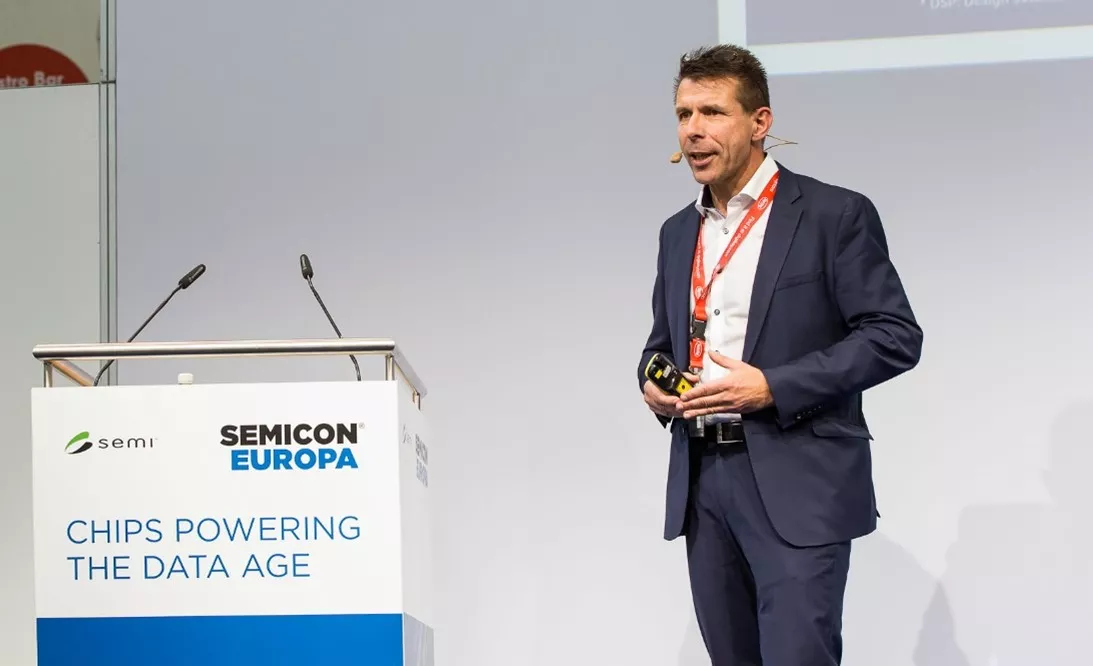
Axel Fischer, Vice President of the EMEA Foundry Business at Samsung Semiconductor
If data is the new oil, then the issue for the industry is not just about production volumes: it is about the compute capacity of the most advanced chips. As stated by Luc Van den hove, the industry must not be limited in its ambition. “What is needed to respond to the demands of technologies such as AI and sensor fusion is a 100x increase in processor capability compared to the situation today,” he said.
The size of this ambition means that the semiconductor industry can afford no let-up in the pace of scaling, which has traditionally been predicted by Moore’s Law. The question remains, is it on track? The answer from Van den hove was a categorical yes.
On this, he said, “Scaling of course is becoming more difficult, as the rate of increase in performance of single transistors slows with each new generation, and the problems of power and heat limit processor performance gains. But we know how to approach the problems – continue to shrink the switch, develop new switch architectures, from FinFET to GAA Nanosheet FETs to CFET technology and improve the processor system with faster interconnects. We will also need to adopt new technologies which are more technology-specific rather than generic for all applications – for instance, evolving from a von Neumann architecture to a neuromorphic architecture for sensor fusion. But it can all be done, and today we already have a roadmap to bring us to nodes far below 1nm and covering the next 10 generations of semiconductor technology as far as the late 2030s.”
His optimism was matched by Lee Choon Heung, Chief Technology Officer of the JCET Group. He described his company’s XDFOI platform, which enables the adoption of new chiplet technology in semiconductor packaging and faster and more nimble approaches to solving the assembly, interconnect, and thermal challenges in designing the next generation of leading-edge semiconductors.
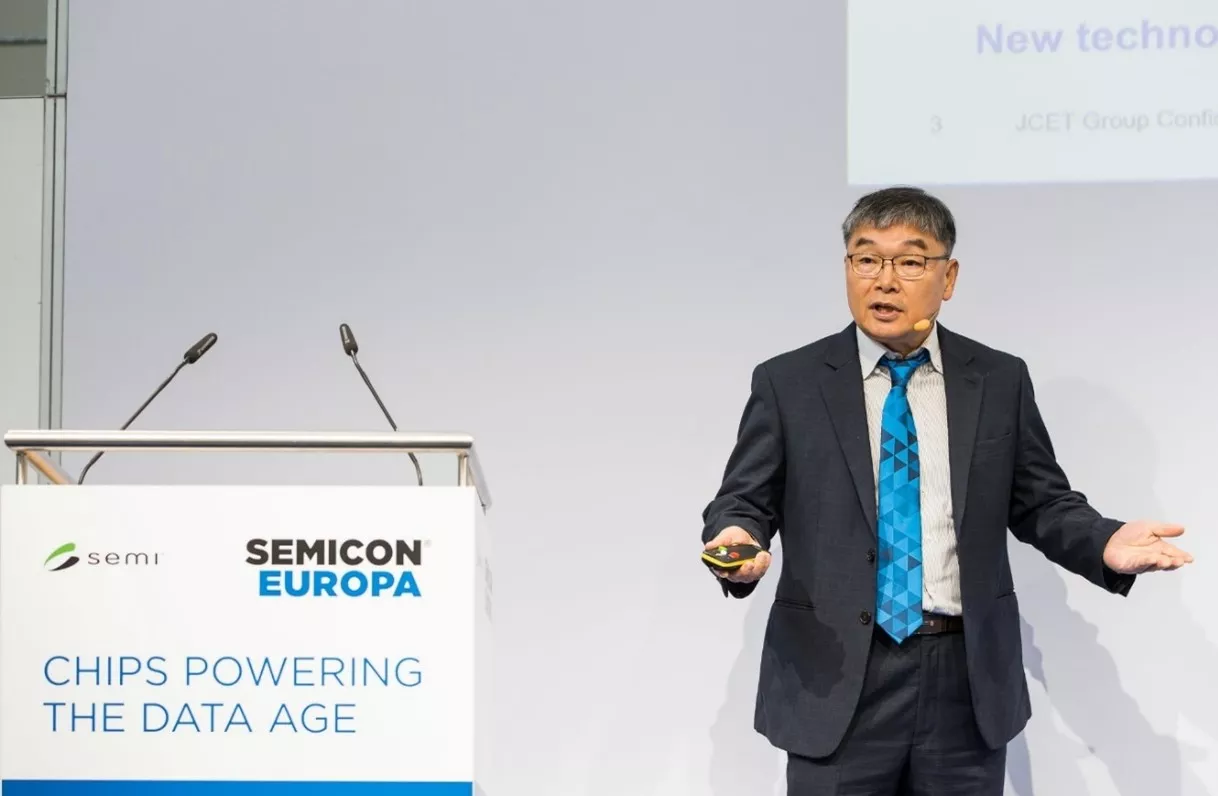
Lee Choon Heung, Chief Technology Officer at JCET Group
Make Sustainability Happen Through Collaboration
A world of opportunity is open to the semiconductor industry. However, Kate Wilson, president of the Semiconductor Division of Edwards Vacuum, sounded one note of caution: as the industry prepares to more than double in size, growth must not come at the expense of the planet. During her presentation Sustainability of the Semiconductor Industry, she insisted, “Our industry needs to commit to science-based targets for reduction in climate and pollution impacts. And this calls for collaboration – we can only make a material difference together.” Collaboration throughout the value chain will be fundamental to overcoming sustainability challenges and reaching Net-Zero. While the challenges – and solutions – are multi-faceted and complex, the industry can be successful if it works collectively and intentionally.
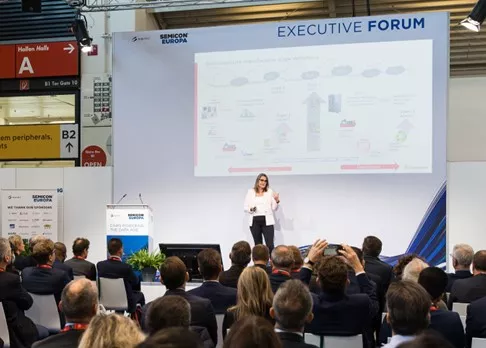
Kate Wilson, President of Semiconductor Division at Edwards Vacuum
SEMI Provides the Forum for Effective Collaboration
While the challenges confronting the industry are many – from supply chain disruptions that impact production across the value chain to leading the path to Net-Zero while accelerating industry growth – the opportunities are even greater for Europe. Semiconductor companies have made remarkable progress already, and with the European Chips Act, they will be supported to drive future growth. However, individual company efforts will not be enough – as noted by Wilson – the industry will only make a difference together.
SEMI provides the platform for effective collaboration and can support companies to collectively empower future progress. Ajit Manocha reinforced this and noted the key areas of SEMI’s work: supply chain re-design, talent and diversity, and – in tune with Kate Wilson’s plea – Net-Zero. He highlighted the new Semiconductor Climate Consortium as a valuable example of the way SEMI could initiate and support collaboration across the industry. The work of the consortium and other operations of SEMI will ensure that the industry continues to grow, and grow sustainably, as it heads into the second half of the decade.
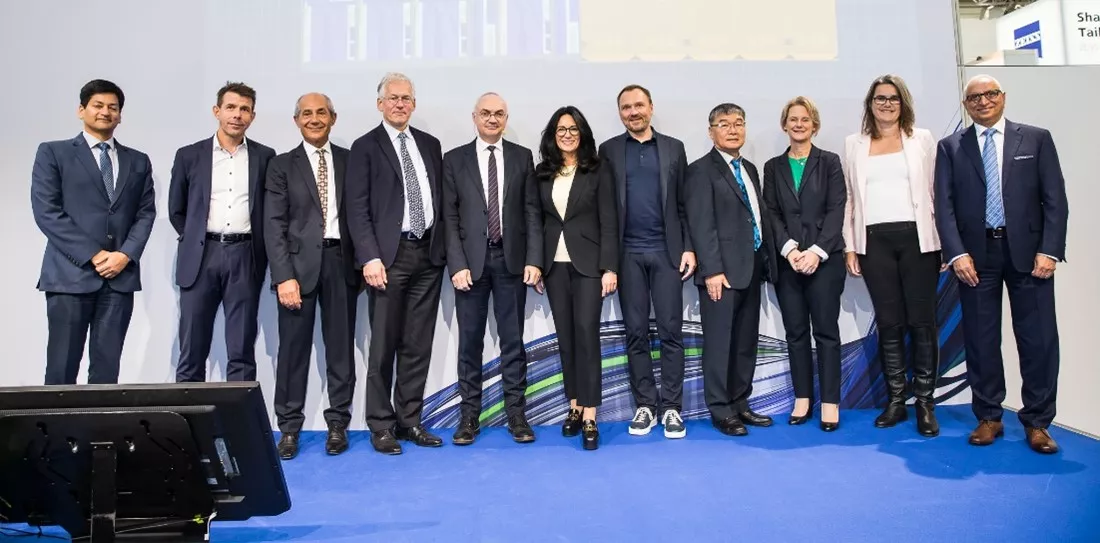
Left to right: Amitesh Kumar Sinha, CEO of the Semiconductor Mission of the Government of India; Axel Fischer, Vice President of the EMEA Foundry Business at Samsung Semiconductors; Laith Altimime, President of SEMI Europe; Frans van Houten, Director at Novartis; Former CEO at Royal Philips; Luc Van den hove, President and CEO at imec; Barbara Frenkel, Member of the Executive Board and Procurement at Porsche AG; Grzegorz Ombach, Head of Disruptive R&T and Senior Vice President at Airbus; Lee Choon Heung, Chief Technology Officer at JCET Group; Laura Matz, Chief Science and Technology Officer at Merck and CEO at Athinia; Kate Wilson, President of the Semiconductor Division at Edwards Vacuum; Ajit Manocha, President and CEO at SEMI
Cassandra Melvin is Senior Director of Business Development and Operations at SEMI Europe.